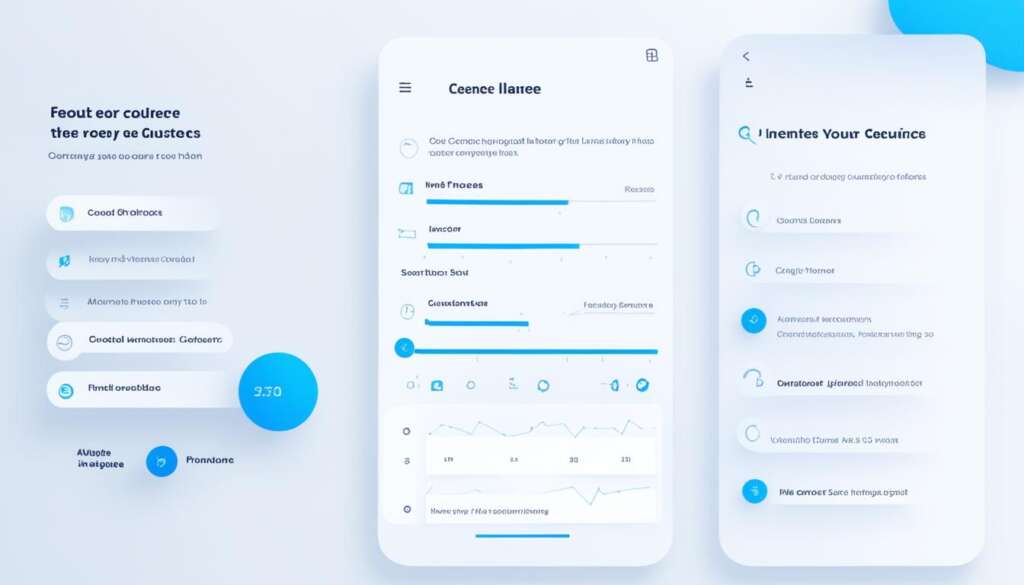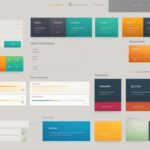Table of Contents
Welcome to our guide on crafting user-centric UX designs that not only engage users but also drive conversions. In today’s competitive digital landscape, it’s essential to create an exceptional user experience that captures the attention of your target audience and converts them into loyal customers. So, let’s dive in and explore the key strategies for designing user-centric experiences that deliver results.
User personas play a crucial role in understanding your target audience. These fictional characters represent groups of real users with similar needs, goals, and pain points. By synthesizing user research data, such as surveys, interviews, and usability testing, you can create accurate personas that provide valuable insights.
Once created, user personas offer a wealth of benefits. They help prioritize features that align with users’ needs and goals, allowing you to focus on what matters most. Additionally, personas guide the design of effective user flows, anticipating users’ needs at every step. By addressing pain points and challenges, you can proactively enhance the user experience.
User personas also inform your content strategy. By understanding the language, tone, and messaging preferences of different user groups, you can create content that resonates with them. Furthermore, personas inspire innovative design solutions by identifying needs and opportunities for improvement.
Creating user-centric UX designs is a holistic process that combines research, empathy, and creativity. By leveraging the power of user personas, you can craft experiences that captivate your audience and drive conversions. Stay tuned as we explore each aspect in detail, providing practical tips and insights along the way.
Prioritizing Features
User personas play a vital role in helping designers prioritize features that align with users’ needs and goals. By understanding user preferences and pain points, designers can identify the most crucial features and functionalities that will provide the most value to the target users. When crafting user-centric UX designs, it is important to align the features with the specific needs and objectives of user personas to create a compelling and engaging experience.
For instance, let’s consider the example of a project manager persona who values seamless collaboration and progress tracking. By prioritizing features like real-time updates, task assignment, and progress visualization, designers can ensure that the design aligns with the project manager’s needs, making the user experience more efficient and enhancing productivity.
Designers can use the insights gained from user personas to create a prioritization framework that considers the importance of each feature based on its relevance to different user segments. This approach helps designers make informed decisions about feature implementation, ensuring that the most critical features are given priority, saving time and resources during the design and development process.
Benefits of Prioritizing Features Based on User Personas
By prioritizing features in alignment with user personas, designers can:
- Focus on developing features that cater to the specific needs and goals of the target audience.
- Ensure that the design delivers maximum value to users, enhancing their overall experience and satisfaction.
- Save time and resources by focusing on the most critical features and avoiding unnecessary development of less important functionalities.
- Create a user-centric design that increases user engagement and drives conversions.
“Understanding user preferences and pain points allows designers to prioritize features that provide the most value.”
By prioritizing features based on the insights gained from user personas, designers can optimize the user experience and deliver a transformative digital product that meets and exceeds the expectations of the target audience.
| Benefits of Prioritizing Features Based on User Personas | |
|---|---|
| Focus on developing features that cater to the specific needs and goals of the target audience. | ✓ |
| Ensure that the design delivers maximum value to users, enhancing their overall experience and satisfaction. | ✓ |
| Save time and resources by focusing on the most critical features and avoiding unnecessary development of less important functionalities. | ✓ |
| Create a user-centric design that increases user engagement and drives conversions. | ✓ |
Designing Effective User Flows
User personas play a crucial role in designing effective user flows. By understanding the needs and goals of the target users, designers can anticipate their needs at each step of the user flow, creating a seamless experience that caters to their objectives.
When crafting user-centric UX designs, it’s important to map out user journeys and workflows. User personas provide valuable insights into the preferences and behaviors of the target audience, allowing designers to create user flows that align with their expectations. By considering the personas’ goals, pain points, and motivations, designers can design intuitive user interfaces that anticipate users’ needs and guide them towards achieving their objectives.
For instance, imagine a persona named Amanda, a frequent traveler who often books flights, accommodations, and activities together. By understanding Amanda’s needs and preferences, designers can create a streamlined user flow that allows her to seamlessly book all activities in a single process. This eliminates the need for multiple interactions and simplifies the overall booking experience.
“By anticipating users’ needs and designing user flows that cater to their objectives, designers can create an engaging and frictionless user experience.”
Designers can utilize personas to identify potential pain points and address them proactively in the user flow. By understanding the challenges faced by different user groups, designers can introduce features or user interface elements that mitigate these pain points and enhance the overall user experience.
By incorporating user personas into the design process, designers can ensure that every step of the user flow is purposeful and aligned with the users’ goals. This level of understanding empowers designers to create user-centric interfaces that resonate with users and make their journey through the website or application intuitive and enjoyable.
| User Persona | Needs | Anticipated User Flow |
|---|---|---|
| Amanda – Frequent Traveler | – Book flights, accommodations, and activities seamlessly | – Single-step booking process with all activities combined |
| John – E-commerce Shopper | – Easy navigation between product categories | – Clear and intuitive category structure with quick access to products |
| Sarah – Health and Fitness Enthusiast | – Track daily exercise and nutrition | – Simplified data entry with intuitive tracking features |
By leveraging user personas, designers can create user flows that not only meet users’ needs but also exceed their expectations. The ability to anticipate users’ needs and design intuitive and seamless user experiences is key to driving conversions and ensuring the success of any digital product.
Addressing Pain Points
User personas play a crucial role in identifying users’ pain points and challenges. By understanding these pain points, designers can proactively address them in the design, enhancing the overall user experience. When it comes to crafting user-centric UX designs, it’s essential to empathize with the needs and frustrations of your target audience.
For example, let’s consider a persona for a busy professional who struggles with managing multiple accounts in a banking app. This persona faces the challenge of juggling various financial responsibilities, leading to a cumbersome and time-consuming experience.
To address this pain point, designers can introduce a unified dashboard that simplifies account management. By providing a centralized view of all accounts, transactions, and balances, the user can easily navigate through their financial information without the hassle of switching between different screens.
An intuitive user interface and clear navigational elements allow users to effortlessly access the information they need, reducing frustration and increasing efficiency. By understanding and empathizing with the persona’s pain points, designers can create an interface that caters to their specific needs.
“The key to addressing pain points lies in putting yourself in the users’ shoes. By understanding their frustrations, you can design solutions that alleviate their challenges and enhance their overall experience.”
By addressing pain points through thoughtful design, you can create a user-centered experience that resonates with your target audience. Prioritizing user persona insights and tailoring the design to address their pain points can lead to higher user satisfaction, increased engagement, and ultimately, conversions.
| User Pain Points | Solution |
|---|---|
| Managing multiple accounts in a banking app | Introduce a unified dashboard for streamlined account management |
| Complex navigation in an e-commerce app | Create an intuitive menu structure and clear categorization |
| Frustrating signup process | Simplify the registration form and provide clear instructions |
By addressing pain points, designers can ensure a smoother and more enjoyable user experience. This not only enhances user satisfaction but also contributes to the success of the product or service. Understanding user pain points and actively working to eliminate them leads to happier users and increased conversion rates.
Content Strategy
User personas play a crucial role in guiding content strategy. By understanding the language, tone, and messaging that resonate with different user groups, designers can craft content that creates a relatable and engaging experience for users. When creating content, it is important to align with the preferences and values of different personas to ensure maximum impact.
For instance, let’s consider an amateur chef using a cooking recipe app. Through user personas, designers can identify that this persona appreciates concise instructions and relatable language. To cater to their cooking style, designers can craft recipes with straightforward steps and casual language that matches their preferences. By doing so, the content will resonate with this specific user group and enhance their overall experience.
“Designing content that aligns with user personas is like speaking their language. It creates a connection and helps establish trust.”
By taking the time to understand the diverse personas of target users, designers can create content that speaks directly to their needs and desires. This not only enhances user engagement but also drives conversions by establishing a strong connection with the users.
Benefits of Crafting User-Centric Content
Designing content that resonates with different user groups yields several advantages:
- Increased user engagement and satisfaction
- Improved brand loyalty and trust
- Better understanding of user needs and preferences
- Enhanced user experience and usability
Example User Persona: Fashion Enthusiast
| Persona | Age | Occupation | Interests |
|---|---|---|---|
| Emily | 28 | Marketing Manager | Fashion, Travel, Photography |
Emily, a 28-year-old marketing manager, is a fashion enthusiast who loves to keep up with the latest trends. Designers can cater to Emily’s interests by creating content that showcases the latest fashion styles, offers styling tips, and provides insights into fashion industry events. By crafting content that resonates with Emily’s persona, designers can engage her and create a meaningful connection with the brand.
Innovative Solutions
User personas serve as a catalyst for innovative design solutions by enabling designers to identify key needs and opportunities. By gaining a deep understanding of the pain points and aspirations of different personas, designers can explore imaginative ways to bridge the gaps and elevate the user experience.
For instance, imagine a persona representing a remote worker who struggles with distractions while trying to focus on tasks. Armed with this insight, designers can develop an innovative “focus mode” feature within a productivity tool. This feature dynamically adjusts notifications and alerts, helping the remote worker maintain concentration and maximize productivity.
By leveraging the power of user personas, designers can unlock unique solutions that address specific pain points and enhance the overall user experience. These personas act as guiding beacons, illuminating untapped opportunities for improvement and inspiring designers to think outside the box.
FAQ
How can I create user-centric UX designs that convert?
To create user-centric UX designs that convert, start by crafting designs that engage users and align with their needs and goals. Incorporate user personas into your design process to understand your target users better and prioritize features that provide the most value. Design effective user flows that anticipate users’ needs at each step, address pain points, and enhance the overall user experience. Tailor your content strategy to resonate with different user groups, using language, tone, and messaging that aligns with their preferences. Finally, leverage user personas to identify needs and opportunities for innovative design solutions that can further enhance the user experience and drive conversions.
How do user personas help prioritize features?
User personas help prioritize features by identifying the most crucial ones that align with the needs and goals of the target users. By understanding user preferences and pain points, designers can prioritize features that will provide the most value to the users. For example, if a persona reveals that a project manager values seamless collaboration and progress tracking, designers can prioritize features like real-time updates, task assignment, and progress visualization to align with their needs.
How do user personas assist in designing effective user flows?
User personas assist in mapping out user journeys and workflows. By understanding the needs and goals of the target users, designers can anticipate users’ needs at each step of the user flow and create a seamless experience that caters to their objectives. For example, if a persona reveals that a frequent traveler often books flights, accommodations, and activities together, designers can create a streamlined user flow that allows them to seamlessly book all activities in a single process.
How do user personas help address pain points?
User personas highlight users’ pain points and challenges. By understanding these pain points, designers can proactively address them in the design, enhancing the overall user experience. For example, if a persona reveals that a busy professional struggles with managing multiple accounts in a banking app, designers can introduce a unified dashboard that simplifies account management and addresses their pain point.
How do user personas guide content creation?
User personas guide content creation by helping designers understand the language, tone, and messaging that resonate with different user groups. By crafting content that aligns with the preferences and values of different personas, designers can create a relatable and engaging experience. For example, if a persona reveals that an amateur chef appreciates concise instructions and relatable language in a cooking recipe app, designers can craft recipes with straightforward steps and casual language to match their cooking style.
How do user personas inspire innovative design solutions?
User personas can inspire innovative design solutions by identifying needs and opportunities for improvement. By understanding the specific pain points and goals of different personas, designers can explore creative ways to address these gaps and enhance the user experience. For example, if a persona reveals that a remote worker struggles with distractions, designers can introduce a unique “focus mode” feature in a productivity tool that dynamically adjusts notifications to help them maintain concentration.













